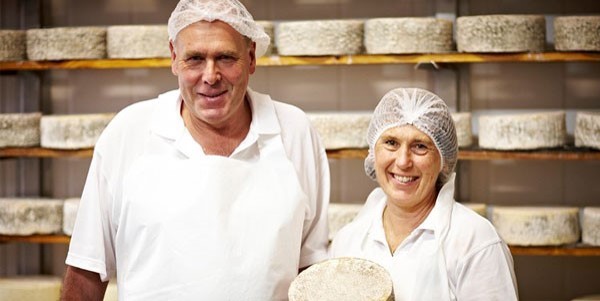From Thomastown to Your Table: The Excellence of Floridia Cheese Melbourne
From Thomastown to Your Table: The Excellence of Floridia Cheese Melbourne
Blog Article
Unlocking the Tricks of Artisanal Cheese Making: A Step-by-Step DIY Overview
In the world of culinary craftsmanship, artisanal cheese making stands as a testament to the delicate balance between tradition and development. As we embark on this journey to demystify the art of developing exquisite cheeses, we are encountered with a tapestry of keys and skills waiting to be unwinded.
Choosing the Right Milk
When embarking on the trip of artisanal cheese production, the selection of milk plays a crucial duty in identifying the top quality and attributes of the final item. The type of milk picked impacts the taste, structure, and in general account of the cheese.
When selecting milk for cheese making, it is vital to think about the fat material. Higher fat material in milk can cause a creamier and richer cheese, while lower fat web content may lead to a drier and firmer structure. Additionally, the resource of the milk, whether from cows, goats, sheep, or buffalo, contributes distinctive flavors and features to the cheese (Floridia Cheese Thomastown). Each sort of milk brings its very own subtleties, permitting a variety of cheese selections to be crafted based on the selected milk. Ultimately, the selection of milk is a basic decision that establishes the structure for a successful artisanal cheese-making venture.
Culturing and Coagulating
To initiate the cheese-making process, the critical actions of culturing and coagulating have to be very carefully implemented to change milk right into curds and whey. Culturing entails presenting helpful microorganisms to the milk, which then starts the fermentation procedure. These microorganisms transform lactose (milk sugar) into lactic acid, producing the acidic environment necessary for coagulation. The kind of culture used can considerably impact the flavor, appearance, and ripening of the last cheese item.

The timing and temperature level control during culturing and coagulation are crucial factors that affect the final result of celebrity. Appropriate execution of these steps is important to ensure the preferred texture, taste, and uniformity of the artisanal cheese being created.
Draining and Pushing Curds
After the milk healthy proteins have actually coagulated and the curds have actually been cut to release whey, the following important action in artisanal cheese making includes draining pipes and pushing the curds to achieve the preferred texture and consistency of the last cheese product. Draining is the procedure of separating the curds from the whey. This can be done by transferring the curds Full Report right into a cheesecloth-lined colander or mold and permitting the whey to drain off naturally. The moment for draining can vary depending on the kind of cheese being made and the preferred dampness content.
Pushing aids get rid of any kind of staying whey and compacts the curds to develop a solid cheese wheel. Appropriate draining and pushing are important steps that substantially affect the quality and qualities of the artisanal cheese being produced.
Aging and Flavor Strategies
Implementing careful aging and flavor techniques is pivotal in boosting the deepness and intricacy of artisanal cheeses, raising their taste profiles to charming degrees of refinement and elegance. Aging plays an essential role in creating the special flavors and textures that identify artisanal cheeses. Throughout the aging process, cheeses are kept in very carefully controlled settings where aspects such as temperature, moisture, and air flow are controlled to encourage the development of useful mold and mildews and germs. This controlled environment permits the cheese to develop slowly, establishing intricate scents and abundant flavors.
Seasoning techniques likewise add dramatically to the final taste of artisanal cheeses. Cheesemakers may select to present added tastes by including active ingredients such as herbs, spices, or perhaps fruits into celebrity during the manufacturing procedure. Additionally, some cheeses are washed or scrubed with numerous fluids, such as brine or alcohol, to improve their tastes and appearances.
Wrapping and Storing Cheeses

Final Thought
In verdict, understanding the art of artisanal cheese making involves thoroughly choosing the appropriate milk, following exact culturing and coagulating procedures, draining pipes and pushing curds effectively, and utilizing various aging and flavoring techniques. Remember to cover and store your cheeses appropriately to make certain optimum taste and appearance growth.
Each kind of milk brings its very own subtleties, enabling for a broad variety of cheese ranges to be crafted based on the picked milk.After the milk proteins have coagulated and the curds have been reduced to launch whey, the following important step in artisanal cheese making involves draining see this and pressing the curds to achieve the desired appearance and uniformity of the final cheese product. Most cheeses must be covered in wax paper or cheese paper to enable them to breathe while safeguarding them from drying out. For cheeses that need to proceed aging, such as bloomy peels or washed rinds, guarantee they are saved in an awesome environment like a cheese cavern or a fridge set to the appropriate temperature level. By paying focus to the wrapping and storage of artisanal cheeses, cheese manufacturers and lovers can preserve the stability of these delicacies and totally appreciate their complicated tastes.
Report this page